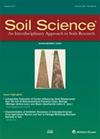利用碳同位素δ13C和F14C评价短生育期珍珠粟根沉积效率
4区 农林科学
Q2 Agricultural and Biological Sciences
引用次数: 3
摘要
摘要根鞘大小随作物基因型的不同而有显著差异,根系分泌物是其驱动因素之一。揭示根鞘形成、根系渗出和土壤碳动力学之间的关系可能为可持续农业作物育种带来有趣的前景。在C3土壤类型(有机质δ13C为- 22.3‰,F14C = 1.045)中,培养了4个根鞘大小对比明显的珍珠粟(c4植物类型:δ13C为- 12.8‰,F14C = 1.012)自交系。在半控制条件下,对生长28 d后的根粘着土(RAS)和散装土进行取样。测定土壤有机碳(SOC)含量、δ13C和F14C,计算RAS中植物源碳量和Clost / Cnew比值。结果表明,与对照土壤相比,4个珍珠粟品系的RAS δ13C显著增加,表明该方法能够检测到珍珠粟生长早期土壤中植物C的输入。在不同品系间,RAS中植物源性C的含量差异不显著,但在考虑不同品系的RAS质量时,植物源性C的绝对含量差异显著。利用概念模型和两种碳同位素的测量数据,我们证明了所有珍珠粟品系都存在启动效应。重要的是,小根鞘(低聚集)线的启动效应幅度(close / Cnew ratio)高于大根鞘(高聚集)线,表明后者具有更好的碳固集潜力。本文章由计算机程序翻译,如有差异,请以英文原文为准。
Rhizodeposition efficiency of pearl millet genotypes assessed on a short growing period by carbon isotopes (δ13C and F14C)
Abstract. Rhizosheath size varies significantly with crop genotype,
and root exudation is one among its driving factors. Unravelling the
relationships between rhizosheath formation, root exudation and soil carbon
dynamics may bring interesting perspectives in terms of crop breeding
towards sustainable agriculture. Here we grew four pearl millet (C4
plant type: δ13C of −12.8 ‰, F14C = 1.012) inbred lines showing contrasting rhizosheath sizes in a C3 soil
type (organic matter with δ13C of −22.3 ‰,
F14C = 1.045). We sampled the root-adhering soil (RAS) and bulk soil
after 28 d of growth under a semi-controlled condition. The soil organic carbon (SOC) content and δ13C and F14C of soil samples were measured and the plant-derived C amount and Clost / Cnew ratio in the RAS were calculated. The results showed a significant increase in δ13C in the RAS of the four pearl millet lines compared to the control
soil, suggesting that this approach was able to detect plant C input into the soil at an early stage of pearl millet growth. The concentration of
plant-derived C in the RAS did not vary significantly between pearl millet
lines, but the absolute amount of plant-derived C varied significantly when
we considered the RAS mass of these different lines. Using a conceptual
model and data from the two carbon isotopes' measurements, we evidenced a priming effect for all pearl millet lines. Importantly, the priming effect amplitude (Clost / Cnew ratio) was higher for the small rhizosheath
(low-aggregation) line than for the large rhizosheath (high-aggregation)
ones, indicating a better C sequestration potential of the latter.
求助全文
通过发布文献求助,成功后即可免费获取论文全文。
去求助
来源期刊

Soil Science
农林科学-土壤科学
CiteScore
2.70
自引率
0.00%
发文量
0
审稿时长
4.4 months
期刊介绍:
Cessation.Soil Science satisfies the professional needs of all scientists and laboratory personnel involved in soil and plant research by publishing primary research reports and critical reviews of basic and applied soil science, especially as it relates to soil and plant studies and general environmental soil science.
Each month, Soil Science presents authoritative research articles from an impressive array of discipline: soil chemistry and biochemistry, physics, fertility and nutrition, soil genesis and morphology, soil microbiology and mineralogy. Of immediate relevance to soil scientists-both industrial and academic-this unique publication also has long-range value for agronomists and environmental scientists.
 求助内容:
求助内容: 应助结果提醒方式:
应助结果提醒方式:


